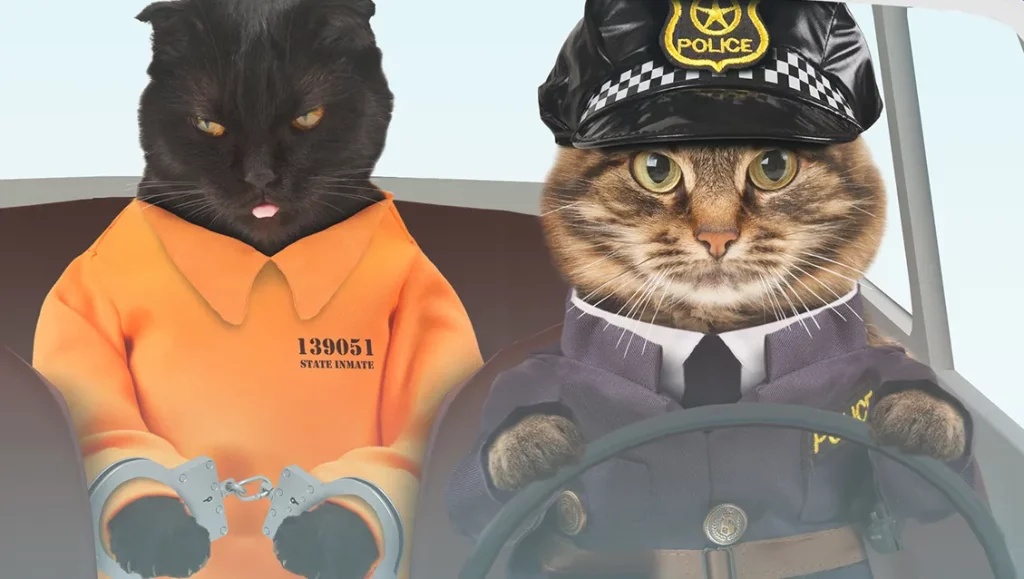The Cat That Saved a Man from the Gallows: The Remarkable Story of Jerry the Police Court Cat

Park City, Utah, 1898. A small mining town in the heart of the Rocky Mountains, where gold and silver were extracted from the earth. A town where life was hard and justice was swift. A town where a black and white cat named Jerry became a legend.
Jerry was not an ordinary cat. He was a cat with a sense of duty and a keen interest in the affairs of men. He lived in the police court of Park City, where he was adopted by Judge John A. Street, a respected and fair-minded jurist. Jerry became the judge’s faithful companion and assistant, often sitting on his desk or on the witness stand during trials. He also helped to keep the court building free of rodents, chasing away any mice or rats that dared to enter.
Jerry was beloved by everyone in the court, from the judge and the lawyers to the clerks and the bailiffs. He was also admired by the citizens of Park City, who considered him a symbol of law and order. Jerry was known for his intelligence and curiosity, as well as his courage and loyalty. He was, in short, the most popular cat in Utah.
But Jerry’s fame reached its peak on a cold December day in 1898, when he performed an act of heroism that saved a man’s life and earned him national recognition.
The man was William H. Smith, a stranger who had arrived in Park City a few weeks earlier. He was accused of murdering a woman named Annie Wilson, who had been found dead in her cabin with a bullet wound in her head. Smith claimed that he had met Wilson at a saloon and that they had gone to her cabin together, but that he had left before she was killed. He said he had no idea who had shot her or why.
The evidence against Smith was circumstantial, but strong enough to arouse suspicion. He had been seen leaving Wilson’s cabin shortly before her body was discovered. He had blood stains on his clothes and a revolver in his possession. He had no alibi for his whereabouts at the time of the murder. And he had no friends or relatives in Park City to vouch for his character.
Smith was arrested and brought to the police court for a preliminary hearing before Judge Street. But as soon as word spread about the murder case, a crowd of angry citizens gathered outside the court building and demanded that Smith be handed over to them. They believed that Smith was guilty and that he deserved to be lynched without delay.
Judge Street refused to bow to the mob’s pressure and ordered that Smith be taken to the county jail for his own safety. But the mob followed them and tried to break into the jail with axes and crowbars. They shouted threats and insults at Smith and swore to hang him from the nearest tree.
The sheriff and his deputies managed to hold off the mob, but they were outnumbered and in danger of being overpowered. They feared that they would not be able to protect Smith from the mob’s wrath.
At that critical moment, Jerry the cat appeared on the scene and changed the course of history.
Jerry had followed Smith from the court to the jail, curious about his fate. He climbed up to the roof of the jail and saw the mob below, trying to force their way in. He sensed that something was wrong and decided to intervene.
He began to meow loudly and incessantly, drawing the attention of the mob. Some of them looked up and saw him on the roof, staring at them with his bright green eyes. They were surprised and amused by his presence and wondered what he was doing there.
Jerry continued to meow, louder and louder, as if he was trying to tell them something. He moved back and forth on the roof, waving his tail and twitching his ears. He seemed to be mocking them and challenging them.
The mob’s anger turned into curiosity and laughter. They forgot about Smith for a moment and focused on Jerry instead. They wondered what he wanted and what he meant by his strange behavior.
This gave the sheriff enough time to call for reinforcements from nearby towns. Soon enough, more deputies arrived on horseback and dispersed the mob with their guns and clubs. The lynching attempt was foiled and Smith was saved.
The next day, newspapers across the country reported on Jerry’s heroic deed. They praised him as a brave and clever cat who had saved a man from certain death. They called him “the cat that saved a man from the gallows” and “the remarkable police court cat”.
Jerry became a national celebrity overnight. He received letters and gifts from admirers all over America. He was invited to visit other towns and cities, where he was greeted with cheers and applause. He even received a medal from a humane society for his courage.
But Jerry remained humble and loyal to his home in Park City. He continued to live in the police court with Judge Street, who treated him as his best friend. He also continued to watch over the trials and chase away any rodents that dared to enter.
Jerry lived a long and happy life as Park City’s most famous resident. He died peacefully in 1906 at the age of 12 (or 84 in cat years). He was buried with honors in a special plot near the court building, where a monument was erected in his memory.
Jerry’s story is still remembered today as an example of how one small cat can make a big difference in this world.












